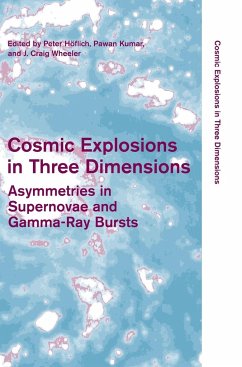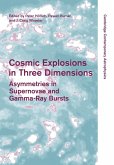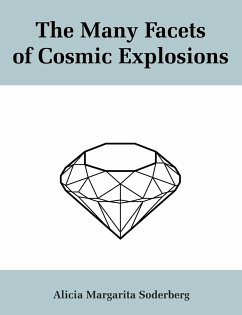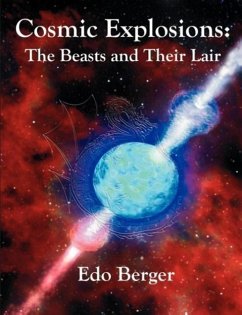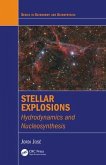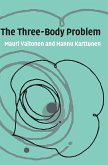Peter Höflich / Pawan Kumar / J. Craig Wheeler (eds.)
Cosmic Explosions in Three Dimensions
Herausgeber: Höflich, Peter; Wheeler, J. Craig; Kumar, Pawan
Peter Höflich / Pawan Kumar / J. Craig Wheeler (eds.)
Cosmic Explosions in Three Dimensions
Herausgeber: Höflich, Peter; Wheeler, J. Craig; Kumar, Pawan
- Gebundenes Buch
- Merkliste
- Auf die Merkliste
- Bewerten Bewerten
- Teilen
- Produkt teilen
- Produkterinnerung
- Produkterinnerung
Supernovae and gamma-ray bursts are the strongest explosions in the Universe. Observations show that, rather than being symmetrical, they are driven by strong jets of energy and other asymmetrical effects. These observations demand theories and computations that challenge the biggest computers. This volume marks the transition to a fresh paradigm in the study of stellar explosions. It highlights the burgeoning era of routine supernova polarimetry and the insights into core collapse and thermonuclear explosions. With chapters by leading scientists, the book summarises the status of a fresh…mehr
Andere Kunden interessierten sich auch für
![Cosmic Explosions in Three Dimensions Cosmic Explosions in Three Dimensions]() Cosmic Explosions in Three Dimensions64,99 €
Cosmic Explosions in Three Dimensions64,99 €![The Many Facets of Cosmic Explosions The Many Facets of Cosmic Explosions]() Alicia SoderbergThe Many Facets of Cosmic Explosions28,99 €
Alicia SoderbergThe Many Facets of Cosmic Explosions28,99 €![Cosmic Explosions Cosmic Explosions]() Edo BergerCosmic Explosions22,99 €
Edo BergerCosmic Explosions22,99 €![Stellar Explosions Stellar Explosions]() Jordi JoseStellar Explosions221,99 €
Jordi JoseStellar Explosions221,99 €![The Three-Body Problem The Three-Body Problem]() Mauri ValtonenThe Three-Body Problem117,99 €
Mauri ValtonenThe Three-Body Problem117,99 €![Quantum Gravity in 2+1 Dimensions Quantum Gravity in 2+1 Dimensions]() Steven CarlipQuantum Gravity in 2+1 Dimensions74,99 €
Steven CarlipQuantum Gravity in 2+1 Dimensions74,99 €![Explosions Of Steam Boilers Explosions Of Steam Boilers]() J. R. RobinsonExplosions Of Steam Boilers10,99 €
J. R. RobinsonExplosions Of Steam Boilers10,99 €-
-
-
Supernovae and gamma-ray bursts are the strongest explosions in the Universe. Observations show that, rather than being symmetrical, they are driven by strong jets of energy and other asymmetrical effects. These observations demand theories and computations that challenge the biggest computers. This volume marks the transition to a fresh paradigm in the study of stellar explosions. It highlights the burgeoning era of routine supernova polarimetry and the insights into core collapse and thermonuclear explosions. With chapters by leading scientists, the book summarises the status of a fresh perspective on stellar explosions and should be a valuable resource for graduate students and research scientists.
Produktdetails
- Produktdetails
- Verlag: Cambridge University Press
- Seitenzahl: 392
- Erscheinungstermin: 28. Juni 2016
- Englisch
- Abmessung: 250mm x 175mm x 26mm
- Gewicht: 854g
- ISBN-13: 9780521842860
- ISBN-10: 0521842867
- Artikelnr.: 22238379
- Herstellerkennzeichnung
- Libri GmbH
- Europaallee 1
- 36244 Bad Hersfeld
- gpsr@libri.de
- Verlag: Cambridge University Press
- Seitenzahl: 392
- Erscheinungstermin: 28. Juni 2016
- Englisch
- Abmessung: 250mm x 175mm x 26mm
- Gewicht: 854g
- ISBN-13: 9780521842860
- ISBN-10: 0521842867
- Artikelnr.: 22238379
- Herstellerkennzeichnung
- Libri GmbH
- Europaallee 1
- 36244 Bad Hersfeld
- gpsr@libri.de
Peter Höflich is a Research Scientist at the University of Texas in Austin, where he mainly works on problems of radiation transport, non-LTE atmospheres, polarization, hydrodynamics and radiation hydrodynamics.
Pawan Kumar is Professor of Astronomy at the University of Texas at Austin where he is a key member of the innovative UTeach science education program. He is an expert on helioseismology.
J. Craig Wheeler is the Samuel T. and Fern Yanagisawa Regents Professor of Astronomy at the University of Texas at Austin, and was Chair of the Astronomy Department from 1986 to 1990.
Pawan Kumar is Professor of Astronomy at the University of Texas at Austin where he is a key member of the innovative UTeach science education program. He is an expert on helioseismology.
J. Craig Wheeler is the Samuel T. and Fern Yanagisawa Regents Professor of Astronomy at the University of Texas at Austin, and was Chair of the Astronomy Department from 1986 to 1990.
Introduction: 3-D Explosions: a meditation on rotation (and magnetic
fields) J. C. Wheeler; Part I. Supernovae: Observations Today: 1. Supernova
explosions: lessons from spectropolarimetry L. Wang; 2. Spectropolarimetric
observations of Supernovae A. Filippenko and D. C. Leonard; 3. Observed and
physical properties of type II plateau supernovae M. Hamuy; 4. SN1997B and
the different types of Type Ic Supernovae A. Clocchiatti, B. Leibundgut, J.
Spyromilio, S. Benetti, E. Cappelaro, M. Turatto and M. Phillips; 5.
Near-infrared spectroscopy of stripped-envelope Supernovae C. L. Gerardy,
R. A. Fesen, G. H. Marion, P. Hoeflich and J. C. Wheeler; 6. Morphology of
Supernovae remnants R. Fesen; 7. The evolution of Supernova remnants in the
winds of massive stars V. Dwarkadas; 8. Types for the galactic Supernovae
B. E. Schaefer; Part II. Theory of Thermonuclear Supernovae: 9. Semi-steady
burning evolutionary sequences for CAL 83 and CAL 87: supersoft X-ray
binaries are Supernovae Ia progenitors S. Starrfield, F. X. Timmes, W. R.
Hix, E. M. Sion, W. M. Sparks and S. Dwyer; 10. Type Ia Supernovae
progenitors: effects of the spin-up of the white dwarfs S.-C. Yoon and N.
Langer; 11. Terrestrial combustion: feedback to the stars E. S. Oran; 12.
Non-spherical delayed detonations E. Livne; 13. Numerical simulations of
Type Ia Supernovae: deflagrations and detonations V. N. Gamezo, A. M.
Khokhlov and E. S. Oran; 14. Type Ia Supernovae: spectroscopic surprises D.
Branch; 15. Aspherity effects in Supernovae P. Hoeflich, C. Gerardy and R.
Quimby; 16. Broad light curve SneIa: asphericity or something else? A.
Howell and P. Nugent; 17. Synthetic spectrum methods for 3-D SN models R.
Thomas; 18. A hole in Ia' spectroscopic and polarimetric signatures of SN
Ia asymmetry due to a companion star D. Kasen; 19. Hunting for the
signatures of 3-D explosions with 1-D synthetic spectra E. Lentz, E. Baron
and P. H. Hauschildt; 20. On the variation of the peak luminosity of Type
Ia J. W. Truran, E. X. Timmes and E. F. Brown; Part III. Theory of Core
Collapse Supernovae: 21. Rotation of core collapse progenitors: single and
binary stars N. Langer; 22. Large scale convection and the convective
Supernova mechanism S. Colgate and M. E. Herant; 23. Topics in
core-collapse Supernova A. Burrows, C. D. Ott and C. Meakin; 24. MHD
Supernova jets: the missing link D. Meier and M. Nakamura; 25. Effects of
super strong magnetic fields in core collapse Supernovae I. S. Akiyama; 26.
Non radial instability of stalled accretion shocks advective-acoustic cycle
T. Foglizzo and P. Galletti; 27. Asymmetry effects in Hypernovae K. Maeda,
K. Nomoto, J. Deng and P.A. Mazzali; 28. Turbulent MHD jet collimation and
thermal driving P. T. Williams; Part IV. Magnetars, N-Stars, Pulsars: 29.
Supernova remnants and pulsar wind nebulae R. Chevalier; 30. X-Ray
signatures of Supernovae D. Swartz; 31. Asymmetric Supernovae and Neutron
Star Kicks D. Lai and D. Q. Lamb; 32. Triggers of magnetar outbursts R.
Duncan; 33. Turbulent MHD Jet Collimation and Thermal Driving P. Williams;
34. The interplay between nuclear electron capture and fluid dynamics in
core collapse Supernovae W. R. Hix, O. E. B. Messer and A. Mezzacappa; Part
V. Gamma-Ray Bursts: 35. GRB 021004 and Gamma-ray burst distances B. E.
Schaefer; 36. Gamma-ray bursts as a laboratory for the study of Type Ic
Supernovae D. Q. Lamb, T. Q. Donaghy and C. Graziani; 37. The diversity of
cosmic explosions: Gamma-ray bursts and Type Ib/c Supernovae E. Berger; 38.
A GRB simulation using 3D relativistic hydrodynamics J. Cannizo, N. Gehrels
and E. T. Vishniac; 39. The first direct link in the Supernova/GRB
connection: GRB 030329 and SN 2003dh T. Matheson; Part VI. Summary: 40.
Three-dimensional explosions C. Wheeler.
fields) J. C. Wheeler; Part I. Supernovae: Observations Today: 1. Supernova
explosions: lessons from spectropolarimetry L. Wang; 2. Spectropolarimetric
observations of Supernovae A. Filippenko and D. C. Leonard; 3. Observed and
physical properties of type II plateau supernovae M. Hamuy; 4. SN1997B and
the different types of Type Ic Supernovae A. Clocchiatti, B. Leibundgut, J.
Spyromilio, S. Benetti, E. Cappelaro, M. Turatto and M. Phillips; 5.
Near-infrared spectroscopy of stripped-envelope Supernovae C. L. Gerardy,
R. A. Fesen, G. H. Marion, P. Hoeflich and J. C. Wheeler; 6. Morphology of
Supernovae remnants R. Fesen; 7. The evolution of Supernova remnants in the
winds of massive stars V. Dwarkadas; 8. Types for the galactic Supernovae
B. E. Schaefer; Part II. Theory of Thermonuclear Supernovae: 9. Semi-steady
burning evolutionary sequences for CAL 83 and CAL 87: supersoft X-ray
binaries are Supernovae Ia progenitors S. Starrfield, F. X. Timmes, W. R.
Hix, E. M. Sion, W. M. Sparks and S. Dwyer; 10. Type Ia Supernovae
progenitors: effects of the spin-up of the white dwarfs S.-C. Yoon and N.
Langer; 11. Terrestrial combustion: feedback to the stars E. S. Oran; 12.
Non-spherical delayed detonations E. Livne; 13. Numerical simulations of
Type Ia Supernovae: deflagrations and detonations V. N. Gamezo, A. M.
Khokhlov and E. S. Oran; 14. Type Ia Supernovae: spectroscopic surprises D.
Branch; 15. Aspherity effects in Supernovae P. Hoeflich, C. Gerardy and R.
Quimby; 16. Broad light curve SneIa: asphericity or something else? A.
Howell and P. Nugent; 17. Synthetic spectrum methods for 3-D SN models R.
Thomas; 18. A hole in Ia' spectroscopic and polarimetric signatures of SN
Ia asymmetry due to a companion star D. Kasen; 19. Hunting for the
signatures of 3-D explosions with 1-D synthetic spectra E. Lentz, E. Baron
and P. H. Hauschildt; 20. On the variation of the peak luminosity of Type
Ia J. W. Truran, E. X. Timmes and E. F. Brown; Part III. Theory of Core
Collapse Supernovae: 21. Rotation of core collapse progenitors: single and
binary stars N. Langer; 22. Large scale convection and the convective
Supernova mechanism S. Colgate and M. E. Herant; 23. Topics in
core-collapse Supernova A. Burrows, C. D. Ott and C. Meakin; 24. MHD
Supernova jets: the missing link D. Meier and M. Nakamura; 25. Effects of
super strong magnetic fields in core collapse Supernovae I. S. Akiyama; 26.
Non radial instability of stalled accretion shocks advective-acoustic cycle
T. Foglizzo and P. Galletti; 27. Asymmetry effects in Hypernovae K. Maeda,
K. Nomoto, J. Deng and P.A. Mazzali; 28. Turbulent MHD jet collimation and
thermal driving P. T. Williams; Part IV. Magnetars, N-Stars, Pulsars: 29.
Supernova remnants and pulsar wind nebulae R. Chevalier; 30. X-Ray
signatures of Supernovae D. Swartz; 31. Asymmetric Supernovae and Neutron
Star Kicks D. Lai and D. Q. Lamb; 32. Triggers of magnetar outbursts R.
Duncan; 33. Turbulent MHD Jet Collimation and Thermal Driving P. Williams;
34. The interplay between nuclear electron capture and fluid dynamics in
core collapse Supernovae W. R. Hix, O. E. B. Messer and A. Mezzacappa; Part
V. Gamma-Ray Bursts: 35. GRB 021004 and Gamma-ray burst distances B. E.
Schaefer; 36. Gamma-ray bursts as a laboratory for the study of Type Ic
Supernovae D. Q. Lamb, T. Q. Donaghy and C. Graziani; 37. The diversity of
cosmic explosions: Gamma-ray bursts and Type Ib/c Supernovae E. Berger; 38.
A GRB simulation using 3D relativistic hydrodynamics J. Cannizo, N. Gehrels
and E. T. Vishniac; 39. The first direct link in the Supernova/GRB
connection: GRB 030329 and SN 2003dh T. Matheson; Part VI. Summary: 40.
Three-dimensional explosions C. Wheeler.
Introduction: 3-D Explosions: a meditation on rotation (and magnetic
fields) J. C. Wheeler; Part I. Supernovae: Observations Today: 1. Supernova
explosions: lessons from spectropolarimetry L. Wang; 2. Spectropolarimetric
observations of Supernovae A. Filippenko and D. C. Leonard; 3. Observed and
physical properties of type II plateau supernovae M. Hamuy; 4. SN1997B and
the different types of Type Ic Supernovae A. Clocchiatti, B. Leibundgut, J.
Spyromilio, S. Benetti, E. Cappelaro, M. Turatto and M. Phillips; 5.
Near-infrared spectroscopy of stripped-envelope Supernovae C. L. Gerardy,
R. A. Fesen, G. H. Marion, P. Hoeflich and J. C. Wheeler; 6. Morphology of
Supernovae remnants R. Fesen; 7. The evolution of Supernova remnants in the
winds of massive stars V. Dwarkadas; 8. Types for the galactic Supernovae
B. E. Schaefer; Part II. Theory of Thermonuclear Supernovae: 9. Semi-steady
burning evolutionary sequences for CAL 83 and CAL 87: supersoft X-ray
binaries are Supernovae Ia progenitors S. Starrfield, F. X. Timmes, W. R.
Hix, E. M. Sion, W. M. Sparks and S. Dwyer; 10. Type Ia Supernovae
progenitors: effects of the spin-up of the white dwarfs S.-C. Yoon and N.
Langer; 11. Terrestrial combustion: feedback to the stars E. S. Oran; 12.
Non-spherical delayed detonations E. Livne; 13. Numerical simulations of
Type Ia Supernovae: deflagrations and detonations V. N. Gamezo, A. M.
Khokhlov and E. S. Oran; 14. Type Ia Supernovae: spectroscopic surprises D.
Branch; 15. Aspherity effects in Supernovae P. Hoeflich, C. Gerardy and R.
Quimby; 16. Broad light curve SneIa: asphericity or something else? A.
Howell and P. Nugent; 17. Synthetic spectrum methods for 3-D SN models R.
Thomas; 18. A hole in Ia' spectroscopic and polarimetric signatures of SN
Ia asymmetry due to a companion star D. Kasen; 19. Hunting for the
signatures of 3-D explosions with 1-D synthetic spectra E. Lentz, E. Baron
and P. H. Hauschildt; 20. On the variation of the peak luminosity of Type
Ia J. W. Truran, E. X. Timmes and E. F. Brown; Part III. Theory of Core
Collapse Supernovae: 21. Rotation of core collapse progenitors: single and
binary stars N. Langer; 22. Large scale convection and the convective
Supernova mechanism S. Colgate and M. E. Herant; 23. Topics in
core-collapse Supernova A. Burrows, C. D. Ott and C. Meakin; 24. MHD
Supernova jets: the missing link D. Meier and M. Nakamura; 25. Effects of
super strong magnetic fields in core collapse Supernovae I. S. Akiyama; 26.
Non radial instability of stalled accretion shocks advective-acoustic cycle
T. Foglizzo and P. Galletti; 27. Asymmetry effects in Hypernovae K. Maeda,
K. Nomoto, J. Deng and P.A. Mazzali; 28. Turbulent MHD jet collimation and
thermal driving P. T. Williams; Part IV. Magnetars, N-Stars, Pulsars: 29.
Supernova remnants and pulsar wind nebulae R. Chevalier; 30. X-Ray
signatures of Supernovae D. Swartz; 31. Asymmetric Supernovae and Neutron
Star Kicks D. Lai and D. Q. Lamb; 32. Triggers of magnetar outbursts R.
Duncan; 33. Turbulent MHD Jet Collimation and Thermal Driving P. Williams;
34. The interplay between nuclear electron capture and fluid dynamics in
core collapse Supernovae W. R. Hix, O. E. B. Messer and A. Mezzacappa; Part
V. Gamma-Ray Bursts: 35. GRB 021004 and Gamma-ray burst distances B. E.
Schaefer; 36. Gamma-ray bursts as a laboratory for the study of Type Ic
Supernovae D. Q. Lamb, T. Q. Donaghy and C. Graziani; 37. The diversity of
cosmic explosions: Gamma-ray bursts and Type Ib/c Supernovae E. Berger; 38.
A GRB simulation using 3D relativistic hydrodynamics J. Cannizo, N. Gehrels
and E. T. Vishniac; 39. The first direct link in the Supernova/GRB
connection: GRB 030329 and SN 2003dh T. Matheson; Part VI. Summary: 40.
Three-dimensional explosions C. Wheeler.
fields) J. C. Wheeler; Part I. Supernovae: Observations Today: 1. Supernova
explosions: lessons from spectropolarimetry L. Wang; 2. Spectropolarimetric
observations of Supernovae A. Filippenko and D. C. Leonard; 3. Observed and
physical properties of type II plateau supernovae M. Hamuy; 4. SN1997B and
the different types of Type Ic Supernovae A. Clocchiatti, B. Leibundgut, J.
Spyromilio, S. Benetti, E. Cappelaro, M. Turatto and M. Phillips; 5.
Near-infrared spectroscopy of stripped-envelope Supernovae C. L. Gerardy,
R. A. Fesen, G. H. Marion, P. Hoeflich and J. C. Wheeler; 6. Morphology of
Supernovae remnants R. Fesen; 7. The evolution of Supernova remnants in the
winds of massive stars V. Dwarkadas; 8. Types for the galactic Supernovae
B. E. Schaefer; Part II. Theory of Thermonuclear Supernovae: 9. Semi-steady
burning evolutionary sequences for CAL 83 and CAL 87: supersoft X-ray
binaries are Supernovae Ia progenitors S. Starrfield, F. X. Timmes, W. R.
Hix, E. M. Sion, W. M. Sparks and S. Dwyer; 10. Type Ia Supernovae
progenitors: effects of the spin-up of the white dwarfs S.-C. Yoon and N.
Langer; 11. Terrestrial combustion: feedback to the stars E. S. Oran; 12.
Non-spherical delayed detonations E. Livne; 13. Numerical simulations of
Type Ia Supernovae: deflagrations and detonations V. N. Gamezo, A. M.
Khokhlov and E. S. Oran; 14. Type Ia Supernovae: spectroscopic surprises D.
Branch; 15. Aspherity effects in Supernovae P. Hoeflich, C. Gerardy and R.
Quimby; 16. Broad light curve SneIa: asphericity or something else? A.
Howell and P. Nugent; 17. Synthetic spectrum methods for 3-D SN models R.
Thomas; 18. A hole in Ia' spectroscopic and polarimetric signatures of SN
Ia asymmetry due to a companion star D. Kasen; 19. Hunting for the
signatures of 3-D explosions with 1-D synthetic spectra E. Lentz, E. Baron
and P. H. Hauschildt; 20. On the variation of the peak luminosity of Type
Ia J. W. Truran, E. X. Timmes and E. F. Brown; Part III. Theory of Core
Collapse Supernovae: 21. Rotation of core collapse progenitors: single and
binary stars N. Langer; 22. Large scale convection and the convective
Supernova mechanism S. Colgate and M. E. Herant; 23. Topics in
core-collapse Supernova A. Burrows, C. D. Ott and C. Meakin; 24. MHD
Supernova jets: the missing link D. Meier and M. Nakamura; 25. Effects of
super strong magnetic fields in core collapse Supernovae I. S. Akiyama; 26.
Non radial instability of stalled accretion shocks advective-acoustic cycle
T. Foglizzo and P. Galletti; 27. Asymmetry effects in Hypernovae K. Maeda,
K. Nomoto, J. Deng and P.A. Mazzali; 28. Turbulent MHD jet collimation and
thermal driving P. T. Williams; Part IV. Magnetars, N-Stars, Pulsars: 29.
Supernova remnants and pulsar wind nebulae R. Chevalier; 30. X-Ray
signatures of Supernovae D. Swartz; 31. Asymmetric Supernovae and Neutron
Star Kicks D. Lai and D. Q. Lamb; 32. Triggers of magnetar outbursts R.
Duncan; 33. Turbulent MHD Jet Collimation and Thermal Driving P. Williams;
34. The interplay between nuclear electron capture and fluid dynamics in
core collapse Supernovae W. R. Hix, O. E. B. Messer and A. Mezzacappa; Part
V. Gamma-Ray Bursts: 35. GRB 021004 and Gamma-ray burst distances B. E.
Schaefer; 36. Gamma-ray bursts as a laboratory for the study of Type Ic
Supernovae D. Q. Lamb, T. Q. Donaghy and C. Graziani; 37. The diversity of
cosmic explosions: Gamma-ray bursts and Type Ib/c Supernovae E. Berger; 38.
A GRB simulation using 3D relativistic hydrodynamics J. Cannizo, N. Gehrels
and E. T. Vishniac; 39. The first direct link in the Supernova/GRB
connection: GRB 030329 and SN 2003dh T. Matheson; Part VI. Summary: 40.
Three-dimensional explosions C. Wheeler.

